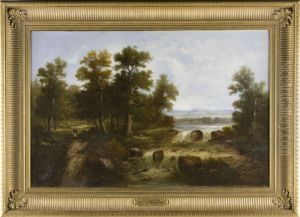Wilhelm Charles Ant. Frerichs Paintings
Wilhelm Charles Ant. Frerichs, often known simply as Wilhelm Frerichs, was a German artist born in 1829 whose work, while not as widely recognized as some of his contemporaries, offers a unique glimpse into the German Romantic and early Realist movements. Frerichs was a painter who managed to capture the transitional essence of his time, blending elements of romanticism with the emerging realist tendencies that would come to define the later years of the 19th century. His artistry is characterized by its detailed natural landscapes, intricate human figures, and an innate ability to capture the subtleties of light and shadow, which adds a dramatic quality to his work.
Frerichs' educational background and artistic training were rooted in the German artistic tradition, studying under prominent artists of his time, which helped him develop a distinct style that was both reflective of the broader movements of the era and deeply personal. Throughout his career, he explored various subjects, including historical scenes, landscapes, and portraiture, showing a versatility and depth of skill that appealed to a wide range of patrons.
Despite his talent and the quality of his work, Wilhelm Frerichs did not achieve the same level of fame as some of his peers. His life and career were relatively short, as he died in 1886 at the age of 57. Nevertheless, his contributions to the art world during the mid-19th century have been appreciated by art historians and collectors who recognize the subtle complexities and beauty of his work. Today, Frerichs' paintings can be found in various art collections and museums, where they continue to be studied and admired for their contribution to the transition from Romanticism to Realism in German art.

